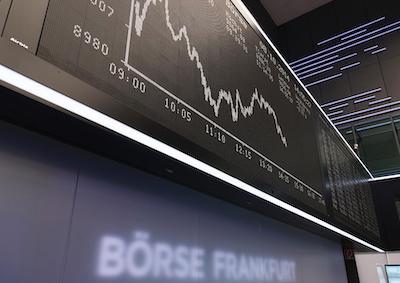European stock markets fell on Wednesday following Fitch’s downgrade of the the US government’s triple-A debt rating.
Rating agency Fitch downgraded the United States to AA+ from AAA, citing fiscal deterioration over the next three years and repeated debt ceiling negotiations that threaten the US government’s ability to pay its bills.
The move by Fitch follows a debt ceiling agreement in June that came after months of political fighting and a deal that eventually lifted the US government’s $31.4 trillion debt ceiling.
Fitch becomes the second major rating agency after Standard & Poor’s to strip the United States of its triple-A rating.
The UK’s FTSE 100 fell 90 points, or 1.18%, to 7,574 in morning trading while the French and German markets fell at least 1.3% and the Spanish and Italian indices both lost 1.1%.
In Asia, markets also fell. Hong Kong’s Hang Seng Index and Japan’s benchmark Nikkei 225 both fell about 2%, and Japan’s broader Topix index dropped 1.1%.
“In Fitch’s view, there has been a steady deterioration in standards of governance over the last 20 years, including on fiscal and debt matters, notwithstanding the June bipartisan agreement to suspend the debt limit until January 2025,” the rating agency said in a statement.
Analysts said the move shows the harm caused to the United States by repeated debates over the debt ceiling, which pushed theUS to the brink of default in May.
US Treasury Secretary Yellen was quick to downplay the announcement, saying it was “arbitrary” and “outdated” and ”does not change what Americans, investors, and people all around the world already know: that Treasury securities remain the world’s preeminent safe and liquid asset, and that the American economy is fundamentally strong.”
REACTION:
Sophie Lund-Yates, lead equity analyst at Hargreaves Lansdown: “The brush with a sovereign debt default earlier this year has seen Fitch Ratings cut the US debt rating, stripping it of its coveted triple A status.
“Fitch highlighted concerns over worsening fiscal conditions over the coming three years, but also brought questions of governance into the spotlight.
“The last-minute saves performed by Washington aren’t the kind of actions held in high esteem by rating agencies, but the lack of movement in US Treasury Bonds and the dollar index suggests the market has already largely quantified and assessed the damage done from recent fall outs.
“It’s true that this move by Fitch is somewhat based on outdated data, especially with the trajectory of inflation now in at a more favourable gradient.”
Lee Hardman, senior currency analyst at MUFG Bank: “When S&P downgraded the US credit rating in August 2011 it triggered a sharp selloff in risk assets and boosted safe haven demand for US Treasuries. The US dollar reaction was more muted.
“On this occasion we are expecting the immediate market reaction to be relatively more modest. The timing of the downgrade was somewhat surprising although Fitch did warn back in May that they were weighing up lowering the credit rating.
“The announcement sheds more light on the health of the US public finances which we have already highlighted as a negative structural factor for US dollar performance over the medium to long-term.
“The US Treasury just announced on Monday that it has increased the net borrowing estimate for Q3 to $1 trillion which is well above the $733 billion it had predicted back in May. The Treasury is due to preview its quarterly financing plans later today.”
“This basically tells you is the U.S. government’s spending is a problem. It’s an unsustainable budget situation because the economy can’t even grow its way out of this problem going forward. Therefore, they’re going to have to either tackle it or accept the consequences of potential further additional downgrades.”
Wendy Edelberg, director of the Hamilton Project at the Brookings Institution, Washington DC: “I’m surprised by the timing of the downgrade because I don’t understand how they (Fitch) have worse information now, then before the debt ceiling crisis was resolved. Before the debt ceiling crisis was resolved, they had put the U.S. on negative watch list but since then we have got a lot of good news regarding the fiscal outlook.”
“I’m also puzzled by how the motivation for the downgrade seems to be about the fiscal trajectory, which is all well and good. Unless they think that fiscal trajectory suggests risk of a default, which I don’t think they say, I don’t understand the reason for this.”
“I think a second downgrade would have mattered more before the debt ceiling deal was reached. That would have had felt reasonably motivated and would have left people much more worried.”
“The effect of the downgrade is surely negative but we will need to wait for a few times to assess its impact.”
